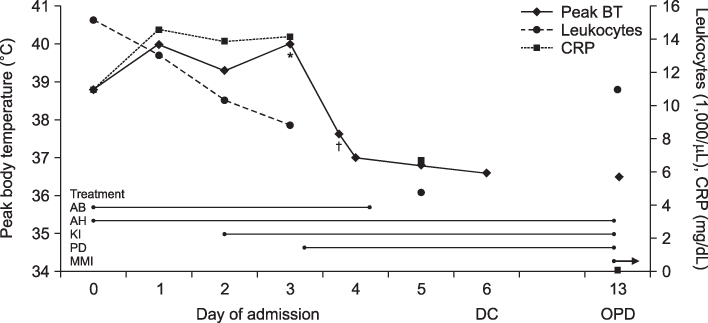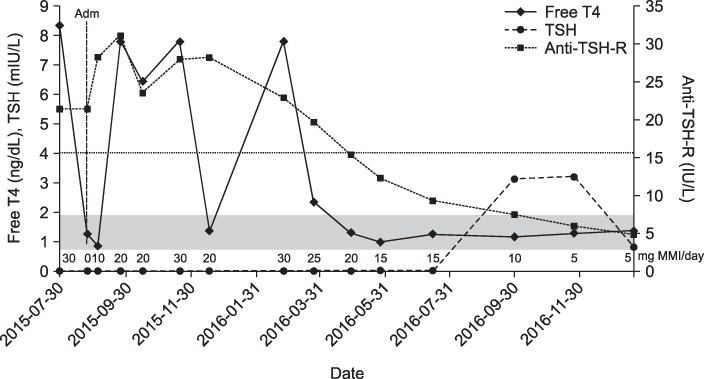Int J Thyroidol.
2017 May;10(1):50-55. 10.11106/ijt.2017.10.1.50.
Sweet's Syndrome Associated with Graves' Disease
- Affiliations
-
- 1Department of Internal Medicine, Dankook University College of Medicine, Dankook University, Cheonan, Korea. dh9070@dankook.ac.kr
- 2Department of Kinesiologic Medical Science, Graduate, Dankook University, Cheonan, Korea.
- KMID: 2379362
- DOI: http://doi.org/10.11106/ijt.2017.10.1.50
Abstract
- Sweet's syndrome, or acute febrile neutrophilic dermatosis, occurs in association with autoimmune diseases such as Hashimoto's thyroiditis but is rare in Graves' disease, in which all cases are induced by propylthiouracil (PTU). We report a case of Sweet's syndrome in a patient with Graves' disease treated with methimazole (MMI) during three weeks. A 34-year-old man presented with the acute onset of high fever, skin rashes on the whole body, arthralgia, and acroparesthesia. Laboratory results showed leukocytosis and elevated C-reactive protein. MMI first stopped and antibiotics and antihistamine therapy started, but his symptoms dramatically improved after oral prednisolone. Graves' disease has again been treated by MMI because of his aggravated ophthalmopathy. After one year of retreatment with MMI, there has been no recurrence of Sweet's syndrome, supporting that Sweet's syndrome in this case was not related to MMI exposure. To our knowledge, this is the first report of Sweet's syndrome associated with Graves' disease per se but not PTU or MMI use.
Keyword
MeSH Terms
Figure
Reference
-
1. Cohen PR. Sweet's syndrome--a comprehensive review of an acute febrile neutrophilic dermatosis. Orphanet J Rare Dis. 2007; 2:34.
Article2. Raza S, Kirkland RS, Patel AA, Shortridge JR, Freter C. Insight into Sweet's syndrome and associated-malignancy: a review of the current literature. Int J Oncol. 2013; 42(5):1516–1522.
Article3. Dabade TS, Davis MD. Diagnosis and treatment of the neutrophilic dermatoses (pyoderma gangrenosum, Sweet's syndrome). Dermatol Ther. 2011; 24(2):273–284.
Article4. Nakayama H, Shimao S, Hamamoto T, Munemura C, Nakai A. Neutrophilic dermatosis of the face associated with aortitis syndrome and Hashimoto's thyroiditis. Acta Derm Venereol. 1993; 73(5):380–381.5. Medeiros S, Santos R, Carneiro V, Estrela F. Sweet syndrome associated with Hashimoto thyroiditis. Dermatol Online J. 2008; 14(9):10.
Article6. Francisco CR, Patal PC, Cubillan EA, Isip-Tan IT. Sweet's syndrome associated with Hashimoto's thyroiditis. BMJ Case Rep. 2011; 2011:pii: bcr0220113921.
Article7. Miller RM, Darben TA, Nedwich J, Savige J. Propylthiouracil-induced antineutrophil cytoplasmic antibodies in a patient with Graves' disease and a neutrophilic dermatosis. Br J Dermatol. 1999; 141(5):943–944.
Article8. Ozlem C, Deram B, Mustafa S, Koray T, Cuyan D, Ertugrul T. Propylthiouracil-induced anti-neutrophil cytoplasmic antibodies and agranulocytosis together with granulocyte colony-stimulating factor induced Sweet's syndrome in a patient with Graves' disease. Intern Med. 2011; 50(18):1973–1976.
Article9. Darne S, Natarajan S, Blasdale C. Do antineutrophil cytoplasmic antibodies (ANCA) play a key role in neutrophilic dermatoses? A case of propylthiouracil-induced neutrophilic dermatosis with positive perinuclear ANCA. Clin Exp Dermatol. 2010; 35(4):406–408.
Article10. Brent GA. Clinical practice. Graves' disease. N Engl J Med. 2008; 358(24):2594–2605.11. Bahn Chair RS, Burch HB, Cooper DS, Garber JR, Greenlee MC, Klein I, et al. Hyperthyroidism and other causes of thyrotoxicosis: management guidelines of the American Thyroid Association and American Association of Clinical Endocrinologists. Thyroid. 2011; 21(6):593–646.
Article12. Gottlieb CC, Mishra A, Belliveau D, Green P, Heathcote JG. Ocular involvement in acute febrile neutrophilic dermatosis (Sweet syndrome): new cases and review of the literature. Surv Ophthalmol. 2008; 53(3):219–226.
Article13. Magri F, Gabellieri E, Sorrentino AR, Rizza MI, Chiovato L, Ferrari E. Sweet's syndrome and thyroid diseases: is there a link? Endocr Abstr. 2006; 11:P64.
- Full Text Links
- Actions
-
Cited
- CITED
-
- Close
- Share
- Similar articles
-
- Sweet's Syndrome Associated with Bacterial Meningitis
- Sweet's Syndrome with Myelodysplastic Syndrome Progressing to Acute Myelogenous Leukemia
- Sweet's Syndrome Associated with Acute Erythema Nodosum
- A case of Sweet's syndrome in patient with dermatomyositis
- A Case of Sweet's Syndrome with Pulmonary Manifestation



